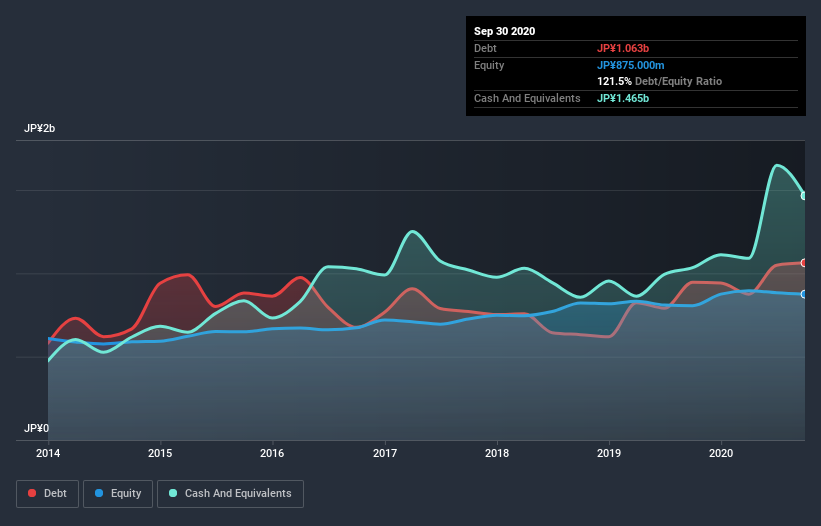- Japan
- /
- Healthcare Services
- /
- TSE:6063
We Think Emergency Assistance Japan (TYO:6063) Can Manage Its Debt With Ease

Legendary fund manager Li Lu (who Charlie Munger backed) once said, 'The biggest investment risk is not the volatility of prices, but whether you will suffer a permanent loss of capital.' It's only natural to consider a company's balance sheet when you examine how risky it is, since debt is often involved when a business collapses. As with many other companies Emergency Assistance Japan Co., Ltd. (TYO:6063) makes use of debt. But should shareholders be worried about its use of debt?
When Is Debt A Problem?
Debt is a tool to help businesses grow, but if a business is incapable of paying off its lenders, then it exists at their mercy. If things get really bad, the lenders can take control of the business. However, a more common (but still painful) scenario is that it has to raise new equity capital at a low price, thus permanently diluting shareholders. Of course, debt can be an important tool in businesses, particularly capital heavy businesses. The first step when considering a company's debt levels is to consider its cash and debt together.
Check out our latest analysis for Emergency Assistance Japan
How Much Debt Does Emergency Assistance Japan Carry?
As you can see below, at the end of September 2020, Emergency Assistance Japan had JP¥1.06b of debt, up from JP¥947.0m a year ago. Click the image for more detail. But on the other hand it also has JP¥1.47b in cash, leading to a JP¥402.0m net cash position.

How Healthy Is Emergency Assistance Japan's Balance Sheet?
We can see from the most recent balance sheet that Emergency Assistance Japan had liabilities of JP¥1.58b falling due within a year, and liabilities of JP¥63.0m due beyond that. Offsetting these obligations, it had cash of JP¥1.47b as well as receivables valued at JP¥103.0m due within 12 months. So its liabilities outweigh the sum of its cash and (near-term) receivables by JP¥72.0m.
Since publicly traded Emergency Assistance Japan shares are worth a total of JP¥2.23b, it seems unlikely that this level of liabilities would be a major threat. But there are sufficient liabilities that we would certainly recommend shareholders continue to monitor the balance sheet, going forward. While it does have liabilities worth noting, Emergency Assistance Japan also has more cash than debt, so we're pretty confident it can manage its debt safely.
Even more impressive was the fact that Emergency Assistance Japan grew its EBIT by 351% over twelve months. That boost will make it even easier to pay down debt going forward. When analysing debt levels, the balance sheet is the obvious place to start. But it is Emergency Assistance Japan's earnings that will influence how the balance sheet holds up in the future. So if you're keen to discover more about its earnings, it might be worth checking out this graph of its long term earnings trend.
Finally, a company can only pay off debt with cold hard cash, not accounting profits. While Emergency Assistance Japan has net cash on its balance sheet, it's still worth taking a look at its ability to convert earnings before interest and tax (EBIT) to free cash flow, to help us understand how quickly it is building (or eroding) that cash balance. Happily for any shareholders, Emergency Assistance Japan actually produced more free cash flow than EBIT over the last three years. There's nothing better than incoming cash when it comes to staying in your lenders' good graces.
Summing up
While it is always sensible to look at a company's total liabilities, it is very reassuring that Emergency Assistance Japan has JP¥402.0m in net cash. The cherry on top was that in converted 126% of that EBIT to free cash flow, bringing in JP¥412m. So is Emergency Assistance Japan's debt a risk? It doesn't seem so to us. There's no doubt that we learn most about debt from the balance sheet. But ultimately, every company can contain risks that exist outside of the balance sheet. For example, we've discovered 2 warning signs for Emergency Assistance Japan that you should be aware of before investing here.
Of course, if you're the type of investor who prefers buying stocks without the burden of debt, then don't hesitate to discover our exclusive list of net cash growth stocks, today.
When trading Emergency Assistance Japan or any other investment, use the platform considered by many to be the Professional's Gateway to the Worlds Market, Interactive Brokers. You get the lowest-cost* trading on stocks, options, futures, forex, bonds and funds worldwide from a single integrated account. Promoted
Valuation is complex, but we're here to simplify it.
Discover if Emergency Assistance Japan might be undervalued or overvalued with our detailed analysis, featuring fair value estimates, potential risks, dividends, insider trades, and its financial condition.
Access Free AnalysisThis article by Simply Wall St is general in nature. It does not constitute a recommendation to buy or sell any stock, and does not take account of your objectives, or your financial situation. We aim to bring you long-term focused analysis driven by fundamental data. Note that our analysis may not factor in the latest price-sensitive company announcements or qualitative material. Simply Wall St has no position in any stocks mentioned.
*Interactive Brokers Rated Lowest Cost Broker by StockBrokers.com Annual Online Review 2020
Have feedback on this article? Concerned about the content? Get in touch with us directly. Alternatively, email editorial-team@simplywallst.com.
About TSE:6063
Emergency Assistance Japan
Provides medical and lifestyle assistance services in Japan and internationally.
Excellent balance sheet slight.
Market Insights
Community Narratives



